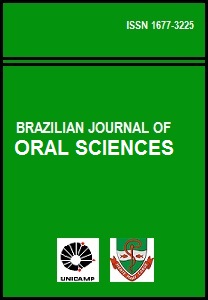Abstract
Enamel pearls are ectopic structures observed mainly on the roots of permanent teeth and could be related to periodontal diseases. Aim: To evaluate the prevalence of enamel pearls in extracted human molars and characterize their structures using light and scanning electron microscopy. Methods: The study comprised 2,201 extracted human permanent molars. The teeth were analyzed and classified according to morphological features. The presence, location and shape of enamel pearls were investigated. Fifteen human molars with enamel pearls were embedded in acrylic resin and observed by light microscopy. Results: Seventy-one enamel earls were
identified on third molar root. Microscopically, most pearls were composed of prismatic irregular enamel and normal dentin. The dentinoenamel junction presented an irregular course. The number of dentinal tubules was normal and they presented curvature to continue within the root dentin of the carrier tooth. Dentinal tubules below the enamel pearls were closer to each other. Conclusions: scanning electron microscopic analysis revealed that the enamel pearls were similar to coronal enamel.
Enamel pearls are ectopic structures observed mainly on the roots of permanent teeth and could be related to periodontal diseases. Aim: To evaluate the prevalence of enamel pearls in extracted human molars and characterize their structures using light and scanning electron microscopy. Methods: The study comprised 2,201 extracted human permanent molars. The teeth were analyzed and classified according to morphological features. The presence, location and shape of enamel pearls were investigated. Fifteen human molars with enamel pearls were embedded in acrylic resin and observed by light microscopy. Results: Seventy-one enamel earls were
identified on third molar root. Microscopically, most pearls were composed of prismatic irregular enamel and normal dentin. The dentinoenamel junction presented an irregular course. The number of dentinal tubules was normal and they presented curvature to continue within the root dentin of the carrier tooth. Dentinal tubules below the enamel pearls were closer to each other. Conclusions: scanning electron microscopic analysis revealed that the enamel pearls were similar to coronal enamel.
The Brazilian Journal of Oral Sciences uses the Creative Commons license (CC), thus preserving the integrity of the articles in an open access environment.

